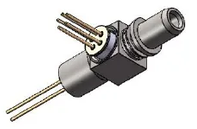Fiber Optic Tech
What Are The Changes Of Optical Transceiver Modules In AI Era?
With the rapid development of artificial intelligence (AI), the field of network communications is ushering in a revolutionary change. This change not only drives the optical module industry to new heights, but also brings unprecedented growth opportunities to the optical module market .
The network architecture of AI clusters is developing towards higher speed, low latency, and lossless, transforming from a leaf-spine structure to a fat-tree structure. This change not only amplifies the demand for high-speed optical modules, but also makes the ratios of H100:800G optical modules under PCIe 5.0 and GH200:800G optical modules under NVLink4.0 reach 1:2.5 and 1:9 respectively. This change means that the application of optical modules will be wider and suitable for more different scenarios and needs.

Moore's Law Accelerates
As a high-speed, efficient and reliable communication method, optical communication is increasingly becoming the core of modern communication networks. In optical communication networks, optical modules are key interface modules that realize photoelectric conversion between equipment and optical fibers, and they play a vital role in optical transmission networks.

Optical modules are mainly composed of two parts: optical devices and auxiliary materials.
· Optical devices include optical chips and optical component components, accounting for more than 70% of the cost of optical modules.
· Accessories include casing, pins, PCB and control chips, etc., occupying the remaining part.
The functions of the optical module mainly include two aspects: light emission and light reception.
· Optical emission assembly (TOSA) converts electrical signals into modulated optical signals at corresponding rates,
· The optical receiving assembly (ROSA) converts optical signals into electrical signals to achieve mutual conversion of optical and electrical signals.
Optical modules are widely used in telecommunication networks, data centers, and AI clusters. In telecommunication networks, optical modules are mainly used in fixed-line access, wireless access, and CWDM/DWDM modules. In data centers, optical modules are used to implement applications such as data center interconnect (DCI). Especially driven by artificial intelligence (AI), the demand for optical modules continues to grow, becoming the key to improving the communication capabilities of computing clusters.
With the explosive growth of information traffic, the optical module market has shown great development potential. The continued investment of technology giants in AI and the continuous development of data centers and AI clusters have further promoted the growth of the optical module market.
It is expected that in the future, as AI networks develop towards multimodality, the application of optical modules will be further expanded and the demand for bandwidth will further increase, injecting new impetus into the optical module market.
The Development of Cloud Computing
With the rapid development of cloud computing and data migration to the cloud, the scale and complexity of data centers are also increasing, and the evolution of network architecture has had a profound impact on the demand for optical modules. The change in data center network architecture is mainly to adapt to the sharp increase in data traffic, and this change directly affects the number and type of optical modules.

The traditional three-layer architecture can no longer meet the growing traffic demand of data centers. The emergence of leaf-spine architecture solves this problem. Under the leaf-spine architecture, the number of optical modules can be as high as dozens of times to meet the needs of large-scale AI clusters for large bandwidth, low latency, and lossless networks. The intelligent computing center network generally adopts a non-blocking Fat-Tree architecture.

NVIDIA's network architecture uses NVLink to achieve efficient interconnection between cards. In its DGX A100 SuperPOD, each server is equipped with 8 GPUs, which are connected through a Fat-Tree architecture. Considering the connection between the server and the switch, the demand for optical modules can reach an astonishing number.

In a data center with GPU as the core, the relationship between GPU and optical modules is very close. For example, in a GH200 cluster, the number of optical modules corresponding to a single GPU can reach an impressive ratio. As data center network performance improves, the demand for high-speed optical modules is also increasing.

As giants in the field of cloud computing, Meta and Google also have unique data center network architecture and optical module requirements. Meta's Research Super Cluster project and Google's TPU array network structure both demonstrate the relationship between data center network architecture and optical module requirements. The evolution of data center network architecture directly affects the number and type of optical modules.
As data centers continue to develop and network performance improves, the demand for high-speed and efficient optical modules will continue to increase. As an important part of the data center network, optical modules will continue to play a key role, supporting the stable operation of the data center and the efficient transmission of information traffic.
As a key component in modern communication networks, optical modules provide strong support for the development of the information age. With the continuous innovation of technology and the continuous growth of market demand, the prospects of optical modules will be broader. Optical modules play an increasingly important role in the future communication field, bringing more convenient and efficient experience to human communication.



















